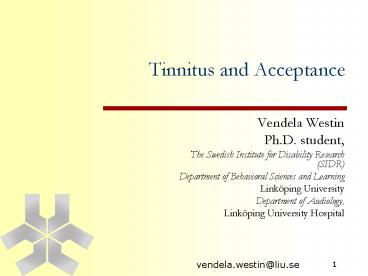Tinnitus and Acceptance - PowerPoint PPT Presentation
1 / 20
Title:
Tinnitus and Acceptance
Description:
The Swedish Institute for Disability Research (SIDR) ... Correlational studies (Batten, Folette, & Abban, 2001), (Bond & Bunce, 2000) ... – PowerPoint PPT presentation
Number of Views:51
Avg rating:3.0/5.0
Title: Tinnitus and Acceptance
1
Tinnitus and Acceptance
- Vendela Westin
- Ph.D. student,
- The Swedish Institute for Disability Research
(SIDR) - Department of Behavioral Sciences and Learning
- Linköping University
- Department of Audiology,
- Linköping University Hospital
vendela.westin_at_liu.se
2
Tinnitus treatment
- Many treatment options have been considered
- CBT has the best empirical support so far
- Cohens d.80 (Andersson Lyttkens, 1999)
- Based on a cognitive model as well as a model of
habituation - Adresses the distress and complaints rather than
the cause - Enhancing the treatment by including acceptance
3
Why acceptance in tinnitus?
- Chronic condition with no evident cure
- Tinnitus patients who have had treatment success
report acceptance of tinnitus as an outcome - Seems to work with pain
- Mindfulness and autobiographical memories in
tinnitus patients - Tinnitus and control of background sounds
4
Control
No Control
Control over background sounds experiment
5
Acceptance
- Third wave behavioral therapies
- Private events Skinners black box
- Relational Frame Theory language and cognition
- The willingness to remain in contact with private
events which may follow functional overt behavior - Not a trait
6
Research on acceptance
- Experimental studies (Hayes, Bissett et al.,
1999), (Guiterez, Luciano, Fink, 2004),
(Feldner, Zvolensky, Eifert Spira, 2003),
(Levitt, Brown, Orsillo, Barlow, 2004) - Correlational studies (Batten, Folette, Abban,
2001), (Bond Bunce, 2000), (McCracken et al.,
2004), (Norberg et al, 2007). - Treatment studies (Hayes et al, 2007)
- Process studies (Acceptance mediator)
7
Two studies conducted
- Experimental design
- n47
- Acceptance/ Thought suppression
- Attention task Imagery
- Longitudinal correlational studie
- n47
- 7 months
- Self-report measures
- Mediation
8
ExperimentÖstergren, Westin Andersson, 2007
- Acceptance/Thought suppression/Neutral
instruction - 5 min instruction
- Attend to imagery
- Maximum 300 sec
- Dependent variables
- Time / Number of times - lost attention/ Changes
in masking level - Self-report of tinnitus strength and tinnitus
distress
9
Results
- After excluding participants due to ceiling
effects - A one-way ANOVA showed a significant effect for
the variable time. - Post hoc tests showed a significant difference
- Acceptance/control
10
Correlational studyWestin, Hayes Andersson,
2007
- Develop a tinnitus specific self-report measure
of acceptance - Investigate if this measure could mediate the
relationship over time between tinnitus distress
and life quality, depression, tinnitus distress
and anxiety.
11
Tinnitus Acceptance Questionnaire
- First we developed a tinnitus specific
self-report measure of acceptance - Tinnitus Acceptance Questionnaire (n77)
- CPAQ-R
- Good internal consistency (a.89)
- Two factors
- Acceptable test-retest reliability (r .77)
12
Correlational studyMeasures
- Tinnitus Handicap Inventory
- Hospital Anxiety and Depression Scale
- Quality of Life Inventory
- Tinnitus Acceptance Questionnaire
13
Mediationa) Illustration of a total effect b)
Mediation analysis model. X affects Y indirectly
through M
14
Statistical analyses
- Baron and Kenny (1982)
- X signicicantly predicts Y
- X significantly predicts M
- M significantly predicts Y controlling for X
- Sobel (Preacher Hayes, 2004)
15
Hierachical regression analysis Tinnitus
acceptance (M) mediating the effects of tinnitus
distress (X) on life quality and depression.
plt 0.01, plt 0.05
16
- Sobel test
- The inclusion of acceptance significantly
decreased the influence of tinnitus distress at
baseline on - Life Quality (Sobel z -2.48, p .013)
- Depression (Sobel z 2.69, p.007)
- Tinnitus distress (Sobel z 2.62, p.009)
- at follow up.
17
Results
- Perfect mediation for the variables depression
and life quality. Patial mediation for tinnitus
distress.
18
On going projectRCT on tinnitus distress
- Comparing Acceptance and Commitment Therapy to
Tinnitus Retraining Therapy (maskers) and a wait
list control.
19
(No Transcript)
20
Discussion
- Importance of acceptance for mental well-being of
tinnitus patients - Imagery task - reliability
- Acceptance differentiated from tinnitus distress?
- How best to measure acceptance

